Week Beginning 1.6.20 Reception Home Learning Overview
Dear Parents and Carers,
I hope that you have all had a wonderful half term break; the weather has been absolutely glorious!
I will be in school from today, preparing the learning environment for next week. I will still be reading and responding to both Tapestry and the class email account daily, but unfortunately I won’t be able to do this as frequently throughout the day, as I have been doing up until now.
To assist me, can I ask that when you upload to Tapestry, you now do this as a daily/ weekly overview of your child’s learning, rather than uploading lots of different posts in one day please? This will help to make things much more manageable!
Thank you for your continued support,
Mrs Theo
This week’s theme is ‘The Bad Tempered Ladybird’
by Eric Carle

*Remember, you do not need to do everything on this overview- just choose one or two things from each area to do over the week.
If you don’t have a copy of the story, don’t worry, you can watch the story here:
Personal, Social and Emotional Development (PSED)
- Focus on turn-taking games as a family- board games, sports etc
- Caring for all minibeasts- how can we help to protect minibeasts?
- How do you think the friendly ladybird felt when the bad tempered ladybird was so rude? Empathise with the friendly ladybird.
- Discuss the consequences of the bad tempered ladybird’s behaviour.
- Discuss how the friendly ladybird responded towards the bad tempered ladybird at the end of the story- link to showing forgiveness. What do we say when someone has been brave enough to say sorry?
Communication and Language
- Why do you think the bad tempered ladybird was so cross?
- What makes you feel cross?
- Play around with your voice- can you talk in a cross voice? Can you talk in a friendly voice? Think about how our voice and body shows how we are feeling.
Physical Development
- Go out for a walk and look for ladybirds (I’ve seen lots over on the farmer’s field next to the school and some over at Furzefield!)
- Find out how a ladybird can fly- how does it move it’s wings? Can you move in the same way? Make yourself some wings that you can wear!
- Making a flying object- measure how far your object goes.
- Make a home for a ladybird and leave it outside- you could leave it wherever you saw some earlier. Check to see if there are any ladybirds inside, the next time you go for a walk.
Understanding the World
Watch these short video about ladybirds:
https://www.bbc.co.uk/programmes/p01cb05t
https://www.bbc.co.uk/newsround/26642067
https://www.youtube.com/watch?v=KPUazqh63kE
- Find out about ladybirds and their habitats. How can we encourage them into our gardens or the outside learning area at school?
- Find out about other bugs that fly.
- Investigate symmetry of natural objects.
- Why are ladybirds red? Do any other minibeasts or animals use colour to keep them safe from predators?
- Look out for warning signs around your home and local area. What dangers are they warning you about?
Expressive Arts and Design
- Paint some rocks to make them look like ladybirds- you could write a little message underneath and leave them for someone to find!
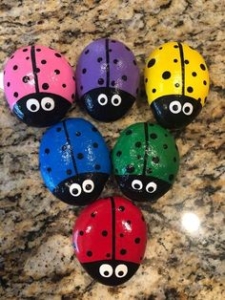
- Make ladybird hand or feet pictures.
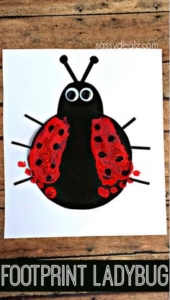
- Make ladybirds from a variety of materials.
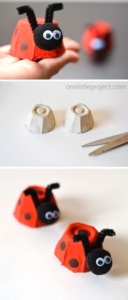
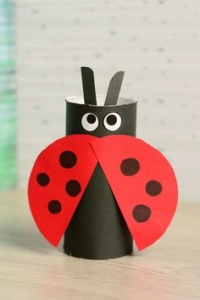
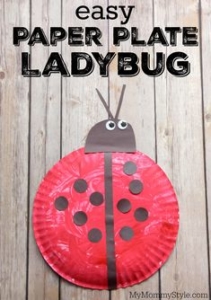
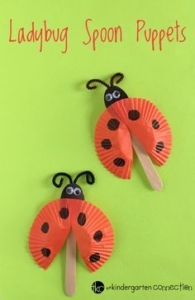
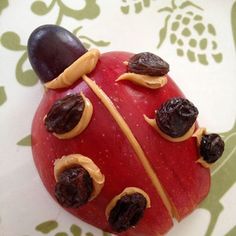
Maths
At this point of the year, we would be focussing on doubling and halving numbers. Ladybirds are a wonderful way to physically see and explore both maths concepts.
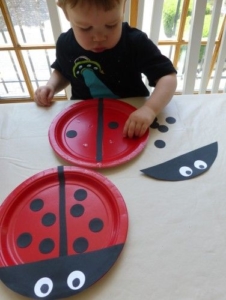
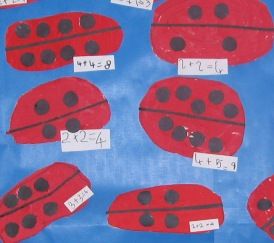
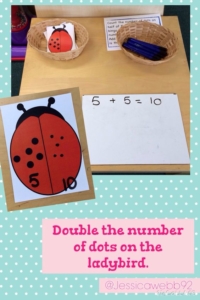
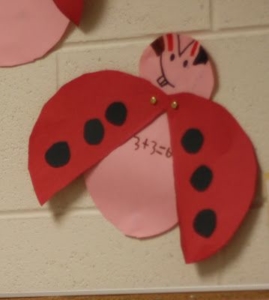
This book lends itself to so many maths themes. Choose from the following:
- Investigating symmetry of natural objects.
- Revisiting clock- O’clock and half past- find out which animal the ladybird was visiting at different times. Can you make your own clock?
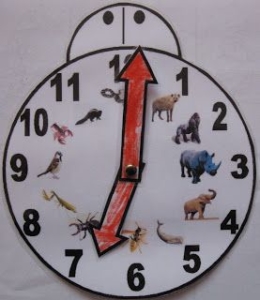
- Size ordering (as in the animals from the book TBTL)
- Find out how many different bugs fly.
- Ladybird symmetry
- Ladybird counting and other games- Topmarks website
Parents, as tempting as it is, please try to limit the number of worksheets you give to your child as eventually, it will take the joy out of learning. The children are used to doing maths activities in a very practical way, both in the inside and outside learning environment. Rather than adding up pictures on a piece of paper, they could be adding up two piles of cars, two groups of daisies, goals scored altogether by two people etc. Thank you!
Literacy
- Sequencing TBTL story. (Twinkl have printable sequencing cards)
- Write sorry cards to the animals from TBTL.
- Write about what makes you feel bad tempered.
- Look at a factual book about bugs/ insects. This type of book is called non-fiction. What would we find inside a non- fiction book? Make your own little fact sheet or book about what you have learnt about ladybirds.
- Draw a picture of the two ladybirds together on the leaf. Draw a speech bubble above each ladybird’s head. Write down what you think they are saying to each other. See picture*
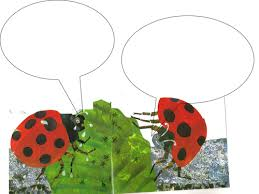
RE
To show that RE is a special learning time, we always light a candle to mark the beginning of lesson and ask ‘Who is with us when we light the candle?’ and ‘Who do we learn about in our RE lesson?’
We then say the school’s Mission Prayer together.

Pentecost
Use a children’s bible to tell the story of Pentecost (Acts 2:1-4) Explain that red is the colour of Pentecost; why do you think that is? Choose from the following:
Explain that Pentecost was (and still is) a Jewish festival. It remembered the first fruit of the season. Make a tree/display with fruit of this summer season.
Pentecost is called the birthday of the Church. Make cards and cake and decorate in red.
Paint the Spirit (which is like fire) using red, yellow and orange paint.
Dance with like fire and wind symbols using red and blue materials.
Make face masks to show how people felt during the story-surprise, fear, amazement, wondering.
Ongoing Further Activities and Information
- Sing daily, using the BBC Schools Radio website- https://www.bbc.co.uk/teach/school-radio/eyfs-early-years/z6bgnrd Again, the class love this website and it will be very familiar to them! The class also really enjoy singing the following songs during special prayer time:https://www.youtube.com/watch?v=8fdk0oKMmfghttps://www.youtube.com/watch?v=Cc0QVWzCv9khttps://www.youtube.com/watch?v=DSpyKsPiUhs
- https://www.youtube.com/watch?v=yjh5Kh5Hxu8
- https://www.youtube.com/watch?v=QCN893hzueQ
- https://www.youtube.com/watch?v=DXDGE_lRI0E
Ongoing Maths Activities – try at least one a day
- Go on a walk and count how many rainbows or teddies you can see in the windows of different houses. Which road has the most?
- Counting objects within the house-This could be anything as simple as counting the cutlery in your drawer!
- Looking for shapes in the environment- Can you see the rectangle on the table? The square on the oven door? How many edges does the bookcase have? Can you name the 3D shape that your cereal box is?
- Using positional and directional language- Where is the teddy? On top, under, behind, in front of, next to, in between etc. Use directions to get from one room to another e.g. walk two steps forward, turn left…
- Capacity-Fill the bath and give them your child whichever containers you have at home (jugs, Tupperware). Encourage the language of full, nearly full, half full, nearly empty, empty. Will the water to fill this container fit into another container?
- Time- Create an ‘at home’ timetable together. What shall we do first? What shall do next? What shall we do at the end of the day? Begin to recognise o’ clock times on a clock.
- Money- Empty your purse or money box. Learn the names of the different coins. Use 1p coins to count and add with.
- Patterns- Use every day objects around the home to create patterns e.g. pen, fork, sock, pen, fork, sock. Can they continue and copy your pattern? Can they make their own pattern.
- Length and height- Find three objects from around the home. Can they order them from smallest to largest? Use your feet to measure the length of items in your home (e.g the sofa). How many feet long is it? Counting objects within the house. This could be anything as simple as counting the cutlery in your drawer!
- Addition using objects found within your home- If we have 5 spoons and 3 forks, how many do we have altogether? Include missing numbers e.g I have 5 buttons. How many more do I need to make 10?
- Subitising (recognising how many without counting) the amount of objects in a set. How many candles are on the fireplace? How many plates are on the table? Etc
- Watch a Numberblocks episode each day at: BBC iplayer or CBeebies.
- Practise counting up to 20. This can be done through playing hide and seek, singing number songs, chanting, board games etc.
- Write out the digits 0 – 9.
- Sing Number songs to practice counting, reciting numbers in order, one more, one less using number songs: Five Little Ducks, Five Little Men, Ten Green Bottles
- Practise counting backwards from 20.
- Look for the numbers on the doors of houses. Do the numbers get bigger or smaller as you go up and down the street?
- Listen to a number song from the CBeebies website. After listening to them, watch again and sing along if you can. Talk about the maths you can see in the video clip.
- Look out of the window and count how many houses or buildings can be seen
- Explore weighing and measuring food on the kitchen scales. Ask, what happens as you place more on the scales?
- Look for numerals on packaging you find around the house. Can your child recognise the numerals and count out a matching amount?
- Subtraction using objects found within your home- If we have 7 biscuits and I eat 2 how many biscuits are left?
- Maths Websiteshttps://www.topmarks.co.uk/maths-games/5-7-years
https://matr.org/blog/fun-maths-games-activities-for-kids/
https://www.primarygames.com/math.php
https://www.bbc.co.uk/cbeebies/topics/numeracy
https://apps.mathlearningcenter.org/geoboard/
White Rose Maths has prepared a series of five maths lessons for each year group from Year R-8. They will be adding five more each week for the next few weeks. Every lesson comes with a short video showing you clearly and simply how to help your child to complete the activity successfully. Click on the link to find out more.
https://whiterosemaths.com/homelearning/
Independent writing
Parents, please encourage your child to write as often as you can, using their phonics and tricky word knowledge. Please take a close up picture of any writing they do and upload it to Tapestry. If they are forming their letters incorrectly, the wrong way around or hold their pencil the wrong way, please correct your child immediately. Please refer to the inside cover of their original home phonics book for the handwriting phrases, if you find yourself in this position.
Phonics
Please continue to practise all of Phase 2 and Phase 3 sounds and tricky words on a daily basis.
Phase 2 tricky and high frequency words
Read: is, it, in, at, and, the, to, no, go, I, on, a
Phase 3 tricky and high frequency words
Read: he, she, we, me, be, was, my, you, they, her, all, are
Write: the, to, no, go, I
For those children who know all of the above, please begin to teach the following words from Phase 4. (Consolidating phase)
Phase 4 tricky words
Read: said, so, have, like, some, come, were, there, little, one, do, when, out, what
Information about Phase 4 Phonics
During the summer term and only when the children are secure in Phase 2 and 3, Reception usually move over to the Phase 4 stage of Letters and Sounds. When children start, they will know a grapheme for each of the 42 phonemes. They will be able to blend phonemes to read CVC (consonant-vowel-consonant) words and segment in order to spell them.
Children will also have begun reading straightforward two-syllable words and simple captions, as well as reading and spelling some tricky words.
In Phase 4, no new graphemes are introduced. The main aim of this phase is to consolidate the children’s knowledge and to help them learn to read and spell words which have adjacent consonants, such as trap, string and milk.
If your child knows all of the Phase 2 and 3 sounds consistently and the high frequency and tricky words, then please begin to introduce your child to the Phase 4 online games and activities.
Important- Please be aware that if you go onto this phase before they are ready, it may cause your child to have issues with spelling later on in their school life.
The following websites are fantastic for practising phonics phases, word recognition and sentence reading.
https://www.teachyourmonstertoread.com
https://www.phonicsplay.co.uk/freeIndex.htm
http://www.familylearning.org.uk
https://www.spellingcity.com/spelling-games-vocabulary-games.html
Twinkl also have some great phonics and cross curricular resources and are also currently free if you follow these instructions:
Go to https://www.twinkl.co.uk/offer and enter the code: UKTWINKLHELPS
Phonics Play in particular is a fantastic resource for the actual teaching of the Letters and Sounds program. It is currently free to parents due to the Coronavirus situation.
Reading
As well as Oxford Owls, Harper Collins Publishers are now giving parents free access to their Big Cat e-books and activities, which are also organised according to book band colour.
Go to Collins Connect and click on the Teacher portal and enter:
Username: parents@harpercollins.co.uk
Password: Parents20!
and then click Login.
To login to Oxford Owl please continue using the school’s login.
Username:popepaul2020
Password:Ilovereading2020
You must put the detail into Class Login not the general login otherwise it will not work. Once logged in, you can go into the bookshelf. Select 2 books from your child’s book band colour and practise reading them every day. There are two activities to go with each book and parent tips at the end of the book. If you click on the parents section too, you should find even more books and resources.


